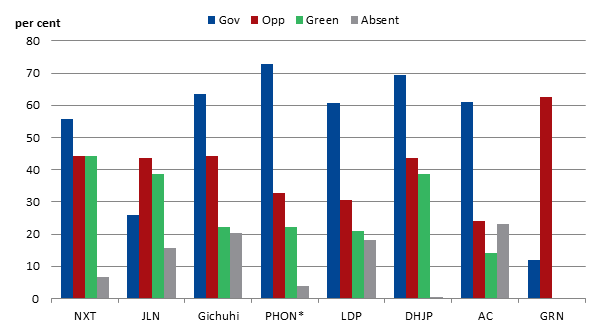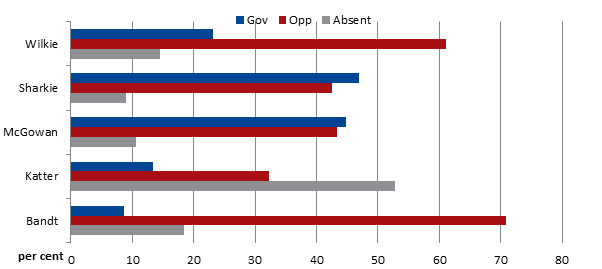Posted 26/09/2017 by Simon Speldewinde
30 August 2017 marked the completion of the first year of the 45th Parliament. In that time there has been continuing interest in the voting records of the Independent parliamentarians and minor parties in both Houses, particularly in the Senate where the Government requires eight out of the 19 crossbench votes (including the seven Australian Greens) to pass legislation. The Parliamentary Library has compiled some statistics on the voting records of the minor parties and Independent MPs in both Houses in that time.
The tables below cover every division in each House. A division may be called in a chamber to decide on any number of questions or motions—for example in relation to legislation, rearrangement of business, censure, or closure of debate. It is important to note that not all matters in either the House of Representatives or the Senate are resolved by a formal division, but can be resolved on the voices without the need for a formal vote. Under section 23 of the Australian Constitution the President of the Senate is entitled to vote in all divisions of the Senate, whereas under section 40 of the Constitution the Speaker of the House of Representatives only votes in the case of a tied vote of the House, and then has a casting vote. So far in the 45th Parliament the current Speaker, the Hon Tony Smith MP, has used his casting vote on two occasions.
For context, of the 254 divisions called in the House of Representatives during the first year of the 45th Parliament, only 34 have been on the second or third readings of legislation (not including amendments moved during the second reading debates or motions to suspend standing orders to debate a bill). In the Senate the equivalent number is 48 out of 372 divisions called over the period.
In the House of Representatives the Government has a majority, and almost always wins any division (most divisions in the House are decided on a majority of the votes actually cast for each division rather than according to a majority of all 150 Members). In the Senate, however, it is far more common for a government to be in the minority in a division as it does not usually hold a majority of seats. In the first year of the 45th Parliament the Government has been in the majority for 271 out of the 372 divisions in the Senate—with the support, often through negotiation, of the Opposition or the crossbench.
Note that each percentage is rounded to the nearest whole number.
Senate
Data for the Senate crossbench (currently 19 senators including the Australian Greens) is taken from Senate StatsNet, with calculations undertaken by the Parliamentary Library. Pauline Hanson’s One Nation Party (PHON) has recorded a ‘split’ vote (at least one member from a party voting in opposition to another member of their party ) on 12 occasions; the only other party to record a split vote was the Coalition when two Coalition senators voted in favour of Senator Leyonhjelm’s disallowance motion on the Customs (Prohibited Imports) Amendment (Shotguns and Shotgun Magazines) Regulation 2016.
The Government and Opposition have voted together in 134 divisions.
Background on the crossbench senators can be found here, although there have been several changes to the composition of the Senate crossbench in the first year of the 45th Parliament. PHON Senator Peter Georgiou replaced fellow PHON Senator Rodney Culleton on 10 March 2017, following the High Court’s disqualification of the latter under section 44 of the Constitution. Senator Cory Bernardi left the Liberal Party on 7 February 2017 to sit first as an Independent, and then later as a Senator for the Australian Conservatives (AC). Senator Lucy Gichuhi was declared elected by the High Court of Australia on 19 April 2017, replacing former Senator Bob Day who resigned on 1 November 2016. The figures for each have been adjusted accordingly.
It should be noted that the Senate only records those senators who are present in the chamber during a division. The reasons for absences are not recorded and thus the numbers below do not discriminate between abstentions, leave or other possible explanations. Full day absences are recorded elsewhere in the Journals.
Figure 1: crossbench voting patterns in the Senate over the first year of the 45th Parliament (by percentage)

Key: NXT= Nick Xenophon Team; JLN= Jacqui Lambie Network; PHON= Pauline Hanson's One Nation; LDP= Liberal Democrats Party; DHJP= Derryn Hinch's Justice Party; AC= Australian Conservatives; GRN= Australian Greens.
House of Representatives
Data for the House of Representatives crossbench (currently five members) has been recorded and calculated by the Parliamentary Library. There have been three divisions where the Government and Opposition have voted together against Independent/minor party MPs. There have also been 11 divisions with fewer than four members on one side; in such cases the House does not proceed to a full vote count. These votes have not been included in the numbers below.
It should be noted that the House of Representatives only records those MPs who are present in the chamber during a division. The reasons for absences are not recorded and thus the numbers below do not discriminate between abstentions, leave or other possible explanations. Full day absences are recorded elsewhere in the Votes and Proceedings.
Figure 2: crossbench voting patterns in the House of Representatives over the first year of the 45th Parliament (by percentage)
